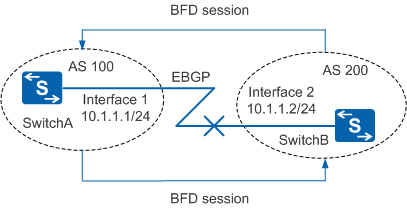BFD for BGP
BGP enables the switch to periodically send Keepalive packets to its peers for fault detection. Detecting a fault using this method takes more than 1 second. When traffic is transmitted at gigabit rates, second-level fault detection times cause significant packet loss. Association between BFD and the Border Gateway Protocol (BGP) enables BFD to quickly detect faults on links between BGP peers and report the faults to BGP, implementing fast BGP route convergence. Table 1 lists the BGP convergence time.
BFD Session |
Link Fault Detection Mechanism |
Convergence Time |
|---|---|---|
Not bound |
Keepalive packet mechanism |
At the second level |
Bound |
BFD session in Down state |
At the millisecond level |
Application
In Figure 1, SwitchA belongs to AS 100, and SwitchB belongs to AS 200. SwitchA and SwitchB are directly connected and establish an External Border Gateway Protocol (EBGP) connection. BFD monitors the status of the EBGP connection between SwitchA and SwitchB. When the link between SwitchA and SwitchB becomes faulty, BFD can quickly detect the fault and notify BGP.
